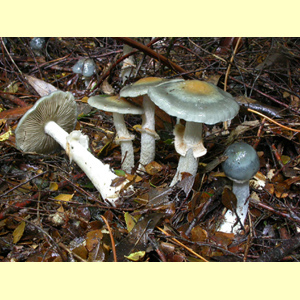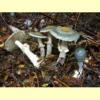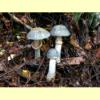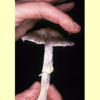


_symeae_sml.jpg)

_AE_28_sml.jpg)
Australian species are : Cortinarius armeniacovelatus (= Rozites), C. elacatipus (= R. fusipes), C. metallicus (= Rozites, pileus bluish grey), C. obtectus (= R. occulta), C. perfoetens (= R. foetens), C. roseolilacinus (= Rozites, pileus pink mauve-lilac), C. submeleagris and C. symeae (= Rozites). Also keyed out in this group is Cortinarius vinaceolamellatus which was placed in Cortinarius subgenus Sericeocybe by Bougher & Syme (1998). However, it has a well-developed membranous annulus, and therefore is grouped alongside the seven former members of Rozites for identification purposes. Cortinarius australiensis, also formerly placed in Rozites, is keyed out separately, due to the massive size of the fruit-body.
Bougher, N.L. & Hilton, R.N. (1989), Three Cortinarius species from Western Australia, Mycol. Res. 93: 424–428. [Description, B&W Illustration and Microcharacters of C. vinaceolamellatus]
Bougher, N.L. & Syme, K. (1998), Fungi of Southern Australia. University of Western Australia Press, Nedlands. [Description, Illustration and Microcharacters of C. symeae (as Rozites) and C. vinaceolamellatus]
Bougher, N.L., Fuhrer, B.A. & Horak, E. (1994), Taxonomy and biogeography of Australian Rozites species mycorrhizal with Nothofagus and Myrtaceae, Austral. Syst. Bot. 7: 353–375. [Description, B&W Illustration, Microcharacters and Key to seven Australian species, all as Rozites]
Fuhrer, B. (2005), A Field Guide to Australian Fungi. Bloomings Books, Hawthorn. [Description and Illustration for C. metallicus, C. perfotetens and C. roseolilacinus, all under Rozites]
Fuhrer, B. & Robinson, R. (1992), Rainforest Fungi of Tasmania and South-east Australia. CSIRO Press, East Melbourne. [Illustration of C. perfoetens (as Rozites sp.)]
Gasparini, B. (2007b), Genus Cortinarius, subgenus Phlegmacium in Tasmania, New Zealand J. Bot. 45: 155–236 [Description, B&W Illustration and Microcharacters of C. submeleagris]
Grey, P. & Grey, E. (2005), Fungi Down Under. Fungimap, South Yarra. [Description, Illustration and Map for C. metallicus, C. roseolilacinus and C. symeae]
Grgurinovic, C.A. (1997a), Larger Fungi of South Australia. The Botanic Gardens of Adelaide and State Herbarium and The Flora and Fauna of South Australia Handbooks Committee, Adelaide. [Description and Microcharacters of C. vinaceolamellatus]
Horak, E. (1981a), Notes on taxonomy and biogeography of Rozites Karsten, Sydowia 34: 94–108.
Horak, E. & Taylor, M. (1980), Fungi agaricini Novaezelandiae XI. Rozites Karsten, New Zealand J. Bot. 19: 353–360. [Key, Description, B&W Illustration and Microcharacters of five New Zealand species, including C. elacatipus (as R. fusipes)]
McCann, I.R. (2003), Australian Fungi Illustrated. Macdown Productions, Vermont. [Illustration of C. roseolilacinus (as Rozites)]
Peintner, U., Horak, E., Moser, M.M. & Vilgalys, R. (2002), Phylogeny of Rozites, Cuphocybe and Rapacea inferred from ITS and LSU rDNA sequences, Mycologia 94: 620–629.
Peintner, U., Moncalvo, J.-M. & Vilgalys, R. (2004), Toward a better understanding of the infrageneric relationships in Cortinarius (Agaricales, Basidiomycota), Mycologia 96: 1042–1058.
